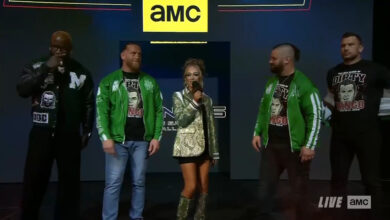Jimmy Van: WWE’s “Women’s Revolution” Didn’t Happen By Accident

There’s been a lot of talk over the last year about the “women’s revolution” in WWE with the emergence of wrestling’s Four Horsewomen – Charlotte, Bayley, Sasha Banks and Becky Lynch – changing women’s matches and making them worthy of main eventing a card. But when you look at the history of women’s wrestling in WWE over the last fifteen years, it’s really no surprise that the quality of the women being recruited has improved. It all comes down to a change in philosophy that started with NXT.
In 2003 with WWE at the back end of the “Attitude Era”, the company came up with the idea for the Diva Search. It was more or less a glorified beauty pageant with the goal of finding the next female talent with mainstream marketability ala Sable, Sunny and Trish Stratus. The winner of the first contest actually only got a photo shoot in WWF Magazine. And here’s a trivia answer for you – the first winner was a Canadian fitness model named Jaime Koeppe who is now apparently a full-time personal trainer.
In 2004, WWE decided to expand the Diva Search concept and devoted time on television to it each week. They apparently got upwards of 7,000 applications and narrowed the field down to ten finalists who then appeared on TV weekly to do various stunts in minimal clothing. One finalist would be voted off weekly reportedly by fan voting (I say “reportedly” since who knows if the fan voting was legit) and the eventual winner would get a one-year contract worth $250,000. They even produced a separate casting special on Spike TV that year. And in order to ensure that the applicants matched WWE’s physical requirements, they reportedly hit up modeling agencies which is where a lot of the applications came from. And because of that, most of the finalists were models or centerfolds who knew little or nothing about wrestling and just looked at the whole thing as another paid gig and opportunity for exposure. I can even recall the live audience on Raw booing Carmella (not to be confused with the current SmackDown talent) when they realized that even though she was arguably the most attractive of the finalists she didn’t know a thing about wrestling and didn’t care to learn. Christy Hemme eventually won that year’s competition which was actually a great pick since she’d grown up a wrestling fan and was genuinely interested in the business, but the Diva Search was so well received that other girls from the contest – again mostly models and wannabe actresses – ended up getting jobs anyway, including Joy Giovanni, Amy Weber, Maria Kanellis, Candice Michelle (not a finalist but she got signed anyway) and Michelle McCool (also a wrestling fan growing up).
The apparent success of the 2004 contest led to another one in 2005 (Ashley Massaro won), 2006 (Layla El won) and 2007 (Eve Torres won) before the concept ran its course. Several of the girls ended up getting enough mainstream attention to be featured centerfolds in Playboy – including Hemme, Michelle, Kanellis and Massaro – but as WWE’s popularity waned, so did their interest from the mainstream outlets.
The problem with the Diva Search concept was obvious. As previously mentioned, John Laurinaitis – then the head of Talent Relations for WWE – turned mostly to modeling agencies for the recruitment of female talent rather than independent wrestling promotions because the company cared more about appearance than ability. That meant that they recruited a bunch of girls that may have looked good in their underwear but had minimal athletic ability, no aptitude for wrestling and in many cases, no interest in training and honing their craft. They simply wanted to try to utilize their WWE TV exposure to land a stupid straight-to-DVD movie role or a commercial spot. And the lack of actual ability led to WWE trying to hide those weaknesses by booking Bra and Panties and Lumberjill matches. Many of the girls from that era simply weren’t capable of working a quality 10-minute wrestling match without killing the crowd and potentially themselves.
Things started to change for the better in 2012. There were still ex-models in the mix but there were also girls with wrestling backgrounds who could work a quality match like Natalya and Beth Phoenix. Plus some of those ex-models put in the work and the effort to improve, including Layla, Eve Torres and the Bellas. That same year, WWE moved its developmental operations to Orlando and created NXT under the guidance of Triple H. He subsequently helped recruit a whole new crop of girls that not only had the physical characteristics that WWE typically went for, but also had actual backgrounds in, or an actual passion for, pro wrestling. Girls like Paige and Emma and Bayley and Sasha Banks. Other ex-models who had worked hard to transition to wrestling were added to the NXT mix to help the new girls, such as Alicia Fox and Summer Rae. By 2014 they’d added Charlotte, Becky Lynch and Alexa Bliss to the roster and utilized additional veterans like Natalya and Layla to work with the girls. It was a complete change in talent recruitment and development, and a complete change in philosophy.
Today the women’s division in the company is probably the deepest and best it’s ever been with the Four Horsewomen on the main roster alongside the Bellas, Natalya, Carmella, Nia Jax and Alexa Bliss, with Asuka tearing it up in NXT. The changes have been well thought out and well received, and all because the company decided to finally choose substance over style for once.



